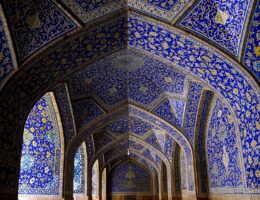IRAN ART EXHIBITION: FIND THE BEST TILE WORKINGS IN IRAN
With an ancient history and civilization in art and an impressive background in pottery, as well as large reserves of raw materials, Iran was a suitable ground for tile and mosaic industry at the end of the 2nd millennium BC.
During the Safavid period, mosaic ornaments were often replaced by a haft rang (seven colors) technique. Pictures were painted on plain rectangle tiles, glazed and fired afterwards. Besides economic reasons, the seven colors method gave more freedom to artists and was less time-consuming. It was popular until the Qajar period, when the palette of colors was extended by yellow and orange. The seven colors of Haft Rang tiles were usually black, white, ultramarine, turquoise, red, yellow and fawn.
In the Safavid period, tile craft reached its peak of progress so that the tile-works of Shah Abbas time in Isfahan are still unique in terms of beauty and color stability. An example of this tile-work is present in Sheikh Lotf Allah Mosque in Isfahan which is the world’s most beautiful moaragh.
Safavid mosques and schools are generally decorated with a cover of tiles both inside and outside. While the use of moaragh tiles was ongoing, Shah Abbas, who was hasty to see his incomplete religious buildings, encouraged the use of seven colors tile rapid technique.
In the Safavid era, seven colors tile was largely used in Isfahan’s palaces and installing rectangular tiles inside large frames created exquisite scenes with portrait elements and different personalities.
IRAN ART EXHIBITION: But oral education and transmission of traditional arts within families or guilds have resulted in elimination of many innovative traditional techniques of tile-setting or tile-work in present time.
The tile is still beautiful and valuable. But nowadays in Iran, the use of traditional tiles is limited to religious monuments or those buildings that insist to pretend traditional. Most of what is built is an imitation of past monuments in a lower level and a trace of creativity can be hardly seen. Spread of Western culture in the native culture and the resulting historical discontinuity has led tile, as a traditional element, not to properly link and function with modern architecture and is mostly considered as a museum issue.

Four main decorative features could be categorized here. They are stone carvings, brick work, stucco and tile panels. The intricate method of manufacture, designs and type of materials used in these four methods have evolved as a result of natural factors, economic and political effects.
The art of tile working blossomed in the Islamic period of Iran. It became the most important decorative feature of religious buildings.
Evidence of brick work, stucco carving and tile panels from the last 14 centuries have provided much evidence of creative and imaginative nature of Persian Artisans. They placed their art in the service of religious architecture. This religious inspiration found its highest expression in ornate inscriptions, which decorated so many works during these centuries.
IRAN ART EXHIBITION: In 8-10th centuries AD., most of these inscriptions included sayings, proverbs, wishes, maxims, names of religious personalities and invocations of Allah’s help, in decorative, simple or broken Kufic script and are found in poetry, such as ceramic wares of Neishabour.
In 13-14th centuries AD., ceramic wares, and tiles were decorated with many different forms of inscriptions. The most popular were molded decorations and inscriptions with messages of happiness, good health, prayers, wish for victory, proverbs, and simple messages of good will, poems and the name of Allah. Workshops at Kashan, Rey and Gorgan produced these types of ware.
Broken Taliq script became popular in 11-14th centuries AD. This script was in luster and under-glaze decoration contained lines from poems and verses of such poets as Ferdowsi, Hafiz, Molana and Baba Afzali Kashani. Furthermore, it became popular for artisans of Kharazmshah and Ilkhanid periods to add the date of manufacture and the name of the maker. The oldest dated tile is of 1203 AD. Tile panels of this period had mostly square, lotus, star and polygonal form and were put together to create panels.
In Safavid era, Naskh and Thulth scripts were used. Works of famous calligraphers, such as Alireza Abbasi, Mohammad Saleh Isfahani, Mohammad Reza Imami and Hossein Banna have been found.
It should be mentioned that the technique of tile and its secrets of trade were safely guarded and orally handed from father to son and master to student; thus rarely have designs, patterns and details of technique been documented and few complete treatises exist on the art of Iranian tile work in the past






